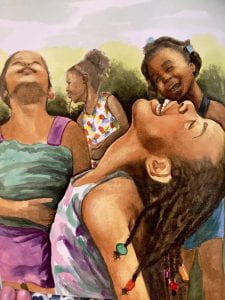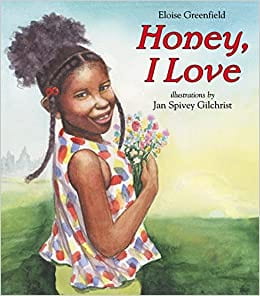Written by Eloise Greenfield
Illustrated by Jan Spivey Gilchrist
Reviewed by Lindsey Smith
Some picture books tackle huge topics. They can attempt to cover a political movement, a large-scale injustice, or tell a winding, elaborate story. Honey, I Love does just the opposite, and it does it very well. The poem, written by Eloise Greenfield in 1978, and the pictures, drawn by Jan Spivey Gilchrist in 2003, work together to tell the story of a young Black child’s simple summer day.
Greenfield, a prolific Black writer and poet, died this year. She’s known for her many books and poems that highlight Black joy and portray everyday events as seen through Black children’s eyes. Honey, I Love, one of her most popular books, is narrated by a child who’s in love with “a whole lot of things,” including her cousin’s Southern accent, looking out the window on the way to a church picnic, and kissing her mother’s arm, “so soft and warm.”
Gilchrist’s illustrations are lively and colorful, yet they stay true to the poem’s simple pleasures. On my favorite page, Gilchrist illustrated four Black girls laughing with their heads thrown back and sun on their faces. The page reads:
We laugh so loud and long and hard
the doll falls to the ground
Honey, let me tell you that
I LOVE the laughing sound
I love to make the laughing sound

Honey, I Love radiates a very pure form of joy. As more and more teachers begin to teach about racism, they can easily fall into the trap of only having books about Black people that talk about Black struggle. While teaching about these realities is important, it’s equally important that children of all races see happy, proud Black children reflected in the books in their classroom. It’s also important they see Black people living ordinary lives. Honey, I Love fulfills both of these goals.
This book’s simple language lends itself well to younger grades. The illustrations are particularly enchanting for young children. I know from experience that preschoolers will sit and stare at the pictures for hours when the book is left out for them to admire. It would make a great complement to any teaching around positive affirmations as well. Older children could certainly study the book to learn about poetry and detailed illustrations, but Honey, I Love is probably most at home in lower elementary.
Because everyday representation and Black joy are buzz phrases right now, I think it’s important to point out that Honey, I Love was written in 1978. While children’s literature is increasingly diverse, a teacher would be remiss to only seek out new releases for their classroom. Black writers have been creating pro-Black children’s literature for decades. W.E.B. du Bois started publishing The Brownies’ Book in 1919! What older, diverse treasures can you welcome into your classroom library?

Your review reads like a tribute to Eloise Greenfield. Thank you for that! I love how you engage with the history of Black joy in children’s books.
Lindsey, thank you for highlighting this book! I agree it is important to cultivate classroom spaces that celebrate Black joy and I love envisioning littles absorbed in the illustrations and poetic language of this book.